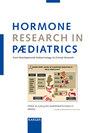塞马鲁肽--一种长效 GLP-1 类似物,用于治疗 MC4R 缺陷导致的早发性肥胖症--病例报告
IF 2.6
3区 医学
Q3 ENDOCRINOLOGY & METABOLISM
引用次数: 0
摘要
引言儿童肥胖症是一个全球关注的问题,它既有营养因素,也有遗传因素。肥胖症最常见的单基因病因之一是黑色素皮质素 4 受体(MC4R)的杂合子突变,5.7% 至 8.6% 的早发性肥胖症患者存在这种突变。我们报告了塞马鲁肽(一种长效胰高血糖素样肽(GLP1)类似物)治疗一名患有 MC4R 杂合突变的青少年重度肥胖症的效果:一名 13 岁的男孩自婴儿期起体重就过度增长,被转介到体重管理专科团队。他足月儿出生时体重为 3.57 千克(第 50 百分位数),但一岁后体重一直超过第 99.6 百分位数。五岁时,他被诊断患有自闭症谱系障碍(ASD)。诊断性检查发现了胰岛素抵抗和血脂异常,而基因检测则证实了他母亲遗传给他的 MC4R(E61K)杂合子突变。由于他体重增加过快、患有针刺恐惧症和行为障碍,治疗他的病情非常困难。尽管采取了密集的多学科生活方式干预措施,他的体重仍在不断增加,13 岁时体重达到峰值 187.5 千克[+16.65 标准差(SDS)],体重指数(BMI)为 56.9 千克/平方米(+4.19 SDS),体脂率为 63.9%]。由于严重的自闭症和打针恐惧症,他不喜欢每天注射 GLP-1。他开始接受塞马鲁肽皮下注射,剂量为每周 0.25 毫克,然后逐渐增加到每周最大剂量 1 毫克。在 12 周内,他的体重指数降至 52.2kg/m2(+4.08SDS),体重降至 176.8kg(+14.76SDS,体脂:52.7%)。在治疗后 3 个月和 12 个月的复查中,他的体重分别下降了 5.7% 和 11%。在 12 个月的复查中,生活质量问卷(QoL)的得分从 35.95 分提高到了 60.36 分,这表明他的健康状况得到了改善。连续血糖监测仪(CGM)显示 TIR(在量程内的时间)有所改善。结论塞马鲁肽于 2022 年 12 月获得 FDA 批准,用于 12 岁及以上青少年的体重管理。最近的一个病例系列强调了使用短效 GLP-1 类似物利拉鲁肽(Liraglutide)治疗罕见遗传性早发肥胖症的益处。据我们所知,这是第一份强调塞马鲁肽在杂合子MC4R突变青少年中的疗效和安全性的病例报告。塞马鲁肽可能是单基因肥胖症的一种潜在治疗选择,并将受益于进一步的研究。本文章由计算机程序翻译,如有差异,请以英文原文为准。
Semaglutide, A Long-Acting GLP-1 Analogue, for the Management of Early Onset Obesity due to MC4R defect – A Case Report
Introduction: Childhood obesity is a global concern and has both nutritional and genetic causative factors. One of the most common monogenic causes of obesity is heterozygous mutations in the Melanocortin 4 receptor (MC4R), which are found in 5.7% to 8.6% of individuals with early-onset obesity. We report, the effect of Semaglutide, a long-acting Glucagon like peptide (GLP1) analogue, in the treatment of severe obesity in an adolescent boy with a heterozygous mutation in MC4R.
Case presentation: A 13-year-old boy with a history of excessive weight gain since infancy was referred to the specialised weight management team. He was born at full-term with a birth weight of 3.57kg (50th centile), but his weight consistently exceeded the 99.6th percentile after the age of one year. At the age of five years, he was diagnosed with autism spectrum disorder (ASD). Diagnostic investigations revealed insulin resistance, and dyslipidaemia, while genetic testing confirmed a heterozygous mutation in MC4R (E61K), inherited from his mother. Managing his condition was challenging due to his rapid weight gain, needle phobia, and behavioural difficulties.
Despite intense multidisciplinary lifestyle interventions, he continued to gain weight, reaching a peak weight of 187.5kg [+16.65 standard deviation score (SDS)], body mass index (BMI) of 56.9kg/m2 (+4.19 SDS), body fat 63.9%] at the age of 13 years. Due to severe ASD and needle phobia, he was not keen on daily GLP-1 injections. He was commenced on Semaglutide subcutaneous injection at a dose of 0.25mg weekly, gradually increasing to the maximum dose of 1mg weekly. Over the course of 12 weeks, his BMI decreased to 52.2kg/m2 (+4.08SDS) and weight dropped to 176.8kg (+14.76SDS, body fat: 52.7%). At the 3-month and 12-month reviews post treatment, he achieved weight loss of 5.7% and 11% respectively. Quality of life questionnaire (QoL) showed improved scores from 35.95 to 60.36 at 12-month review indicating enhanced well-being. The CGM (continuous glucose monitor) demonstrated an improvement in TIR (time in range).
Conclusion: Semaglutide, is approved by the FDA for weight management in adolescents aged 12 years and above in December 2022. A recent case series underscored the benefits of therapy with Liraglutide, a short-acting GLP-1 analogue, in rare genetic cases of early-onset obesity. To our knowledge, this is the first case report to highlight the efficacy and safety of Semaglutide in an adolescent with heterozygous MC4R mutation. Semaglutide could be a potential treatment option for monogenic obesity and will benefit from further research.
求助全文
通过发布文献求助,成功后即可免费获取论文全文。
去求助
来源期刊

Hormone Research in Paediatrics
ENDOCRINOLOGY & METABOLISM-PEDIATRICS
CiteScore
4.90
自引率
6.20%
发文量
88
审稿时长
4-8 weeks
期刊介绍:
The mission of ''Hormone Research in Paediatrics'' is to improve the care of children with endocrine disorders by promoting basic and clinical knowledge. The journal facilitates the dissemination of information through original papers, mini reviews, clinical guidelines and papers on novel insights from clinical practice. Periodic editorials from outstanding paediatric endocrinologists address the main published novelties by critically reviewing the major strengths and weaknesses of the studies.
 求助内容:
求助内容: 应助结果提醒方式:
应助结果提醒方式:


